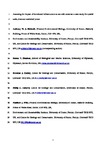Assessing the impact of introduced infrastructure at sea with cameras: A case study for spatial scale, time and statistical power
| dc.contributor.author | Bicknell, AWJ | |
| dc.contributor.author | Sheehan, Emma | |
| dc.contributor.author | Godley, BJ | |
| dc.contributor.author | Doherty, PD | |
| dc.contributor.author | Witt, MJ | |
| dc.date.accessioned | 2019-05-01T13:47:36Z | |
| dc.date.available | 2019-05-01T13:47:36Z | |
| dc.date.issued | 2019-04-16 | |
| dc.identifier.issn | 0141-1136 | |
| dc.identifier.issn | 1879-0291 | |
| dc.identifier.uri | http://hdl.handle.net/10026.1/13760 | |
| dc.description.abstract |
Detecting the effects of introduced artificial structures on the marine environment relies upon research and monitoring programs that can provide baseline data and the necessary statistical power to detect biological and/or ecological change over relevant spatial and temporal scales. Here we report on, and assess the use of, Baited Remote Underwater Video (BRUV) systems as a technique to monitor diversity, abundance and assemblage composition data to evaluate the effects of marine renewable energy infrastructure on mobile epi-benthic species. The results from our five-year study at a wave energy development facility demonstrate how annual natural variation (time) and survey design (spatial scale and power) are important factors in the ability to robustly detect change in common ecological metrics of benthic and bentho-pelagic ecosystems of the northeast Atlantic. BRUV systems demonstrate their capacity for use in temperate, high energy marine environments, but also how weather, logistical and technical issues require increased sampling effort to ensure statistical power to detect relevant change is achieved. These factors require consideration within environmental impact assessments if such survey methods are to identify and contribute towards the management of potential positive or negative effects on benthic systems. | |
| dc.format.extent | 126-137 | |
| dc.format.medium | Print-Electronic | |
| dc.language | en | |
| dc.language.iso | en | |
| dc.publisher | Elsevier | |
| dc.rights | Attribution-NonCommercial-ShareAlike 4.0 International | |
| dc.rights | Attribution-NonCommercial-ShareAlike 4.0 International | |
| dc.rights | Attribution-NonCommercial-ShareAlike 4.0 International | |
| dc.rights | Attribution-NonCommercial-ShareAlike 4.0 International | |
| dc.rights | Attribution-NonCommercial-ShareAlike 4.0 International | |
| dc.rights | Attribution-NonCommercial-ShareAlike 4.0 International | |
| dc.rights | Attribution-NonCommercial-ShareAlike 4.0 International | |
| dc.rights | Attribution-NonCommercial-ShareAlike 4.0 International | |
| dc.rights | Attribution-NonCommercial-ShareAlike 4.0 International | |
| dc.rights | Attribution-NonCommercial-ShareAlike 4.0 International | |
| dc.rights.uri | http://creativecommons.org/licenses/by-nc-sa/4.0/ | |
| dc.rights.uri | http://creativecommons.org/licenses/by-nc-sa/4.0/ | |
| dc.rights.uri | http://creativecommons.org/licenses/by-nc-sa/4.0/ | |
| dc.rights.uri | http://creativecommons.org/licenses/by-nc-sa/4.0/ | |
| dc.rights.uri | http://creativecommons.org/licenses/by-nc-sa/4.0/ | |
| dc.rights.uri | http://creativecommons.org/licenses/by-nc-sa/4.0/ | |
| dc.rights.uri | http://creativecommons.org/licenses/by-nc-sa/4.0/ | |
| dc.rights.uri | http://creativecommons.org/licenses/by-nc-sa/4.0/ | |
| dc.rights.uri | http://creativecommons.org/licenses/by-nc-sa/4.0/ | |
| dc.rights.uri | http://creativecommons.org/licenses/by-nc-sa/4.0/ | |
| dc.subject | Marine monitoring | |
| dc.subject | Human impact | |
| dc.subject | Renewable energy | |
| dc.subject | Power analysis | |
| dc.subject | BRUV | |
| dc.title | Assessing the impact of introduced infrastructure at sea with cameras: A case study for spatial scale, time and statistical power | |
| dc.type | journal-article | |
| dc.type | Journal Article | |
| plymouth.author-url | https://www.webofscience.com/api/gateway?GWVersion=2&SrcApp=PARTNER_APP&SrcAuth=LinksAMR&KeyUT=WOS:000471359000013&DestLinkType=FullRecord&DestApp=ALL_WOS&UsrCustomerID=11bb513d99f797142bcfeffcc58ea008 | |
| plymouth.volume | 147 | |
| plymouth.publication-status | Published | |
| plymouth.journal | Marine Environmental Research | |
| dc.identifier.doi | 10.1016/j.marenvres.2019.04.007 | |
| plymouth.organisational-group | /Plymouth | |
| plymouth.organisational-group | /Plymouth/Faculty of Science and Engineering | |
| plymouth.organisational-group | /Plymouth/Faculty of Science and Engineering/School of Biological and Marine Sciences | |
| plymouth.organisational-group | /Plymouth/PRIMaRE Publications | |
| plymouth.organisational-group | /Plymouth/REF 2021 Researchers by UoA | |
| plymouth.organisational-group | /Plymouth/REF 2021 Researchers by UoA/UoA07 Earth Systems and Environmental Sciences | |
| plymouth.organisational-group | /Plymouth/Users by role | |
| plymouth.organisational-group | /Plymouth/Users by role/Academics | |
| dc.publisher.place | England | |
| dcterms.dateAccepted | 2019-04-11 | |
| dc.rights.embargodate | 2019-12-18 | |
| dc.identifier.eissn | 1879-0291 | |
| dc.rights.embargoperiod | Not known | |
| rioxxterms.funder | EPSRC | |
| rioxxterms.identifier.project | Partnership for Research In Marine Renewable Energy (PRIMaRE) | |
| rioxxterms.versionofrecord | 10.1016/j.marenvres.2019.04.007 | |
| rioxxterms.licenseref.uri | http://creativecommons.org/licenses/by-nc-sa/4.0/ | |
| rioxxterms.licenseref.startdate | 2019-04-16 | |
| rioxxterms.type | Journal Article/Review | |
| plymouth.funder | Partnership for Research In Marine Renewable Energy (PRIMaRE)::EPSRC |



